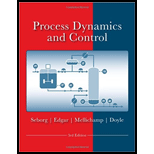
Find the Laplace transforms of the following functions, using the information in Table 3.1. (However, someof the individual terms in these functions may not have Laplace transforms.)
a.
b.
c.
d.
(a)
Interpretation:
Laplace transform of
Concept introduction:
For a function
Here,
Answer to Problem 3.1E
Explanation of Solution
The Laplace transform of the function of type
Laplace transform of the function of type
Laplace transform of the function of type
Now, for the given function
For
For
For
Combine the Laplace transformsof
(b)
Interpretation:
Laplace transform of
Concept introduction:
For a function
Here,
Answer to Problem 3.1E
Explanation of Solution
The Laplace transform of the function of type
Laplace transform of the function of type
The Laplace transform of the function of type
The Laplace transform of the function of type
Now, for the given function
For
For
For
For
For
Combine the Laplace transforms of
(c)
Interpretation:
Laplace transform of
Concept introduction:
For a function
Here,
Answer to Problem 3.1E
Explanation of Solution
The Laplace transform of the function of type
The Laplace transform of the function of type
Now, for the given function
For
For
Combine the Laplace transforms of
(d)
Interpretation:
Laplace transform of
Concept introduction:
For a function
Here,
Answer to Problem 3.1E
Explanation of Solution
Simplify the given function and expand using the formula
Note that
The Laplace transform of the function of type
The Laplace transform of the function of type
The Laplace transform of the function of type
The Laplace transform of the function of type
The Laplace transform of the function of type
Now, for the simplified function
For
For
For
For
For
Combine the Laplace transforms of
Want to see more full solutions like this?
Chapter 3 Solutions
Process Dynamics and Control, 4e
Additional Engineering Textbook Solutions
Elements of Chemical Reaction Engineering (5th Edition) (Prentice Hall International Series in the Physical and Chemical Engineering Sciences)
Structural Steel Design (6th Edition)
Starting Out with Java: From Control Structures through Objects (6th Edition)
Starting Out with Python (3rd Edition)
Experiencing MIS
Web Development and Design Foundations with HTML5 (9th Edition) (What's New in Computer Science)
 Introduction to Chemical Engineering Thermodynami...Chemical EngineeringISBN:9781259696527Author:J.M. Smith Termodinamica en ingenieria quimica, Hendrick C Van Ness, Michael Abbott, Mark SwihartPublisher:McGraw-Hill Education
Introduction to Chemical Engineering Thermodynami...Chemical EngineeringISBN:9781259696527Author:J.M. Smith Termodinamica en ingenieria quimica, Hendrick C Van Ness, Michael Abbott, Mark SwihartPublisher:McGraw-Hill Education Elementary Principles of Chemical Processes, Bind...Chemical EngineeringISBN:9781118431221Author:Richard M. Felder, Ronald W. Rousseau, Lisa G. BullardPublisher:WILEY
Elementary Principles of Chemical Processes, Bind...Chemical EngineeringISBN:9781118431221Author:Richard M. Felder, Ronald W. Rousseau, Lisa G. BullardPublisher:WILEY Elements of Chemical Reaction Engineering (5th Ed...Chemical EngineeringISBN:9780133887518Author:H. Scott FoglerPublisher:Prentice Hall
Elements of Chemical Reaction Engineering (5th Ed...Chemical EngineeringISBN:9780133887518Author:H. Scott FoglerPublisher:Prentice Hall
 Industrial Plastics: Theory and ApplicationsChemical EngineeringISBN:9781285061238Author:Lokensgard, ErikPublisher:Delmar Cengage Learning
Industrial Plastics: Theory and ApplicationsChemical EngineeringISBN:9781285061238Author:Lokensgard, ErikPublisher:Delmar Cengage Learning Unit Operations of Chemical EngineeringChemical EngineeringISBN:9780072848236Author:Warren McCabe, Julian C. Smith, Peter HarriottPublisher:McGraw-Hill Companies, The
Unit Operations of Chemical EngineeringChemical EngineeringISBN:9780072848236Author:Warren McCabe, Julian C. Smith, Peter HarriottPublisher:McGraw-Hill Companies, The





